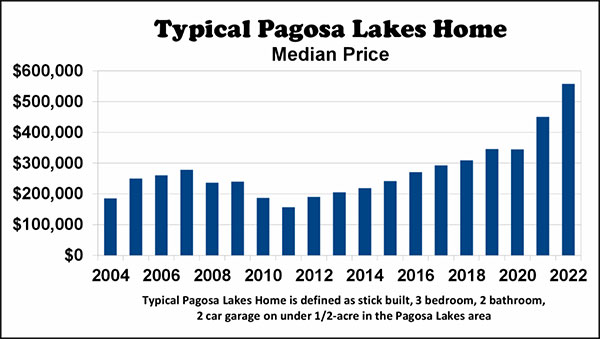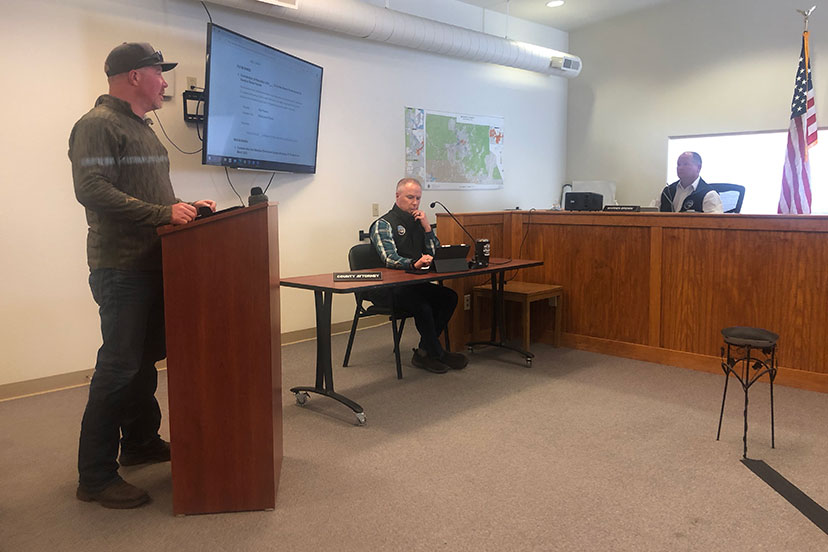PHOTO: Realtor Mike Knapp testifies on behalf of the STR industry at the March 15 Archuleta Board of County Commissioners’ meeting.
Yesterday, Tuesday March 14, might have been a fateful day for the future of Archuleta County neighborhoods, and its economy.
But we don’t yet know for sure.
At their 1:30pm regular meeting, the three County commissioners — Veronica Medina, Ronnie Maez, and Warren Brown — voted unanimously not to extend the County’s six-month moratorium on Vacation Rental permits. That moratorium expired on March 1 without seeing any new Short-Term Rental policies enacted, in spite of receiving recommendations from the County Planning Department staff (last summer)… and two citizen groups that also brought forward policy recommendations more recently.
The rejected resolution on the BOCC agenda yesterday would have extended the moratorium until June. During public comment on the resolution, two realtors — Mike Knapp and Shelley Low — urged the commissioners to lift the moratorium. A third member of the public (me) encouraged them to continue the moratorium until they had adopted regulations that would protect the quality of neighborhoods, and address our local housing crisis.
The commissioners took the advice from the realtors.
Earlier the same day, the BOCC had finally received a partial recommendation from the Vacation Rental Task Force that has been meeting behind closed doors — fearful of public exposure? — since September. That Task Force was expected to deliver recommendations to the County by early December, so that the County Planning Commission and BOCC could implement some, or all, of the recommendations by the time the STR moratorium expired on March 1.
The Phase I recommendations arrived, instead, on March 14… about three months behind schedule. We are still going to have to wait a while for Phase II, apparently.
Perhaps the most important recommendation from the Task Force (TF) — considering yesterday’s proposed resolution to possibly extend the moratorium — was to lift the moratorium and allow the local housing market to show us where it wants to go, unregulated, for at least the next 12 months.
Economic drivers such as low interest rates and COVID-19 contributed to the rise in home prices in 2020-2021, and now that interest rates have risen and COVID-19 restrictions have lifted, the TF suggests that the market run its normal course until a certain percentage of saturation is reached, which would then trigger another moratorium and opportunity to look at more conclusive data.
The partial recommendations, which we were told were not endorsed by the entire task force, generally concerned suggestions for better enforcing ‘good behavior’ on the part of STR renters and STR property managers.
You can download the 37-page report here.
The group would continue meeting (they suggested) for the next year, to determine what other policies might benefit the tourism industry or, alternately, appease the angry neighbors of STR units.
Phase II of the TF will begin in April 2023 to meet regularly over the next twelve months to go over data collected to review trends and analyze the effectiveness of the new policies and recommendations. In an effort of transparency, the TF would like the data to be published publicly. The existing TF will also consider other recommendations, including potentially setting density caps or other creative solutions, to preserve quality of life in our beloved County.
I have to say, this may be the only government report I’ve read in my eighteen years of writing for the Daily Post, that used the phrase “our beloved County”.
One thing has become very apparent during the process of tracking STR growth in Archuleta County. No one seems to know how many STRs are operating illegally, without permits. At the morning work session, County Manager Derek Woodman suggested that we might have “100” unpermitted STRs operating within the unincorporated county.
The Task Force report claims that the County Planning Department permitted 588 STRs in 2022.
The data coming from vacation rental website AirDNA.co listed 994 “active rentals” as of yesterday in the 81147 zip code. The Town government claims to have about 120 permitted STRs.
The number of “active rentals” on AirDNA changes weekly, and has ranged as high as 1,300 during the summer season.
We understand that the cost of real estate and the price of rents in Pagosa Springs has skyrocketed over the past 10 years, as shown by this graph:

The cost of a modest Pagosa Lakes home has doubled since its previous peak in 2007, and more than tripled since the recent low point in 2011.
Was this price increase driven by investors snapping up Pagosa homes and converting them to STR operations? Depends on what you want to believe.
The Task Force proposed that the driver in home purchases may have been low interest rates. From page 10 of the report:

As we all know (or should know) correlation is not the same as causation. The chart above purports that to show that the number of homes sold in Pagosa Springs was somehow related to the interest rate.
But we must point out that the number of parcels sold in 2020 (638) when the interest rate was below 3%, does not come close to the number of parcels sold annually in Pagosa Springs between 1995 and about 2002, when the mortgage interest rate averaged about 6%.
Much more likely, the number of homes purchased in Pagosa Springs in 2020 and 2021, and converted into STRs, was related to real estate promotions such as the one published by Vacasa that listed Pagosa Springs as one of the 25 best places to make a killing with a vacation rental.

In some cases, the recommendations from the Task Force are aimed at the problems faced by the non-STR neighbors dealing with disturbances caused by disrespectful STR renters.
For example:
Recommendation: County should publish STR permit address and owner/management company contact information. Permit holder should notify new neighbors annually when renewing a permit.
If the STR management software allows, the County should publish a list — or better yet, a search form — of STR permit holders in Archuleta County. Neighbors could then find STR permit holders within 250 feet of their property and contact the owner or management company directly with any concerns. When a permit renews, the permit holder should check for new neighbors, through changes in property ownership, who have purchased property within 250 feet of the subject property in the past year. The permit holder will only need to send the notification form to new neighbors within 250 feet and not to every neighbor within 250 feet.
During the presentation of this Task Force report by County Manager Derek Woodman — in summary form — the three commissioners engaged in some friendly disagreements about how to allow the STR industry to grow, while also acknowledging the fact many full-time residents abhor the presence of STRs in their residential neighborhoods.

